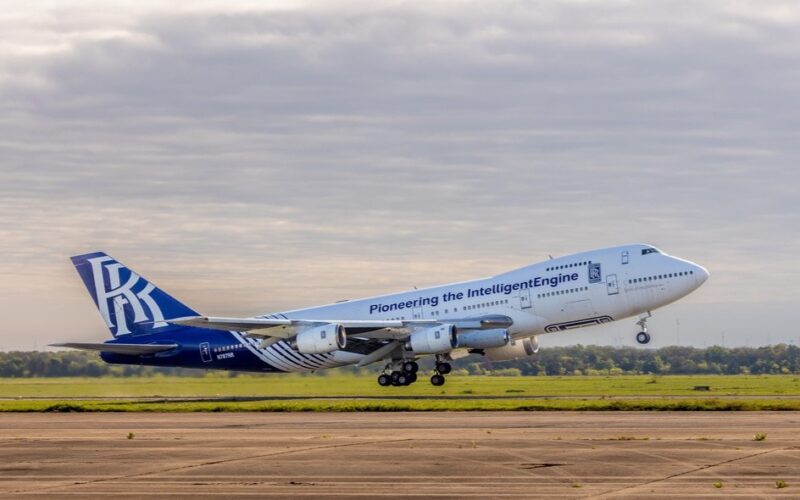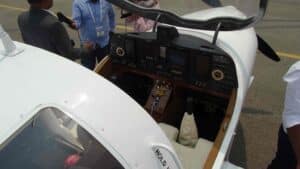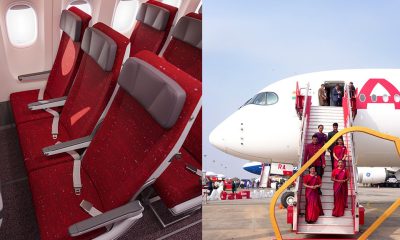Aerospace
Meet the HANSA-NG, a two-seat flying training aircraft developed in India.

- HANSA-NG, India’s first indigenous flying trainer, has successfully completed the sea-level trials
- The aircraft was flown to Puducherry on February 19, in which it covered a distance of 140 nautical miles in 1.5 hours at a cruising speed of 155 km/hr.
HANSA–NG Aircraft designed and developed by CSIR-NAL is major attraction in Wings 2022. HANSA-NG was piloted by Wg. Cdr. Dilip Reddy, an Experimental Test Pilot of IAF. He has demonstrated its flying capabilities like climb, descend, maneuvering, low level stability and short take off /landing, exciting the viewers.
HANSA-NG is one of the most advanced two seat flying trainer aircraft powered by Rotax Digital Control Engine with unique features like Just-In-Time Prepreg (JIPREG) Composite lightweight Airframe, Glass Cockpit, Bubble Canopy with wide panoramic view, electrically operated flaps, etc.
HANSA NG is capable offlying upto an altitude of 10000ft with max speed of 200 kmph with more than 5 hrs endurance. HANSA –NG completed more than 55 hours of flying and will be type certified by DGCA shortly. NAL has already received more than 80 nos. of LoIs (Letter of Intents) from various flying clubs across the country and delivery is scheduled from July 2022.
New Generation aircraft called the HANSA-NG has been developed by incorporating the state-of-the-art technologies and New Generation Design features. It offers advanced digital display systems using certified instruments, two primary flight displays with built in redundant power supply.
The indigenous HANSA-NG will benefit Indian Flying Clubs as well as other customer applications like bird reconnaissance at airfields, cadet training, coastal surveillance, and hobby flying. As a result of this, CSIR-NAL received firm commitments for 10 Nos from M/s Belagavi Aviation Pvt Ltd during Wings India 2022. M/s Blue ray aviation has also shown interest in acquiring 3 nos of the aircraft during the WingsIndia.
World’s first ‘fly and drive car’ ready by 2021
Hansa New Generation, abbreviated as HANSA-NG, India’s first indigenous flying trainer, has successfully completed the sea-level trials as Puducherry from February 19 to March 5. The flying trainer has been designed and developed by the Council of Scientific & Industrial Research (CSIR) – National Aerospace Laboratories (NAL).
The aircraft was flown to Puducherry on February 19, in which it covered a distance of 140 nautical miles in 1.5 hours at a cruising speed of 155 km/hr. Objective Of Trials The sea-level trials were conducted to evaluate handling qualities, climb and cruise performance, balked landing, structural performance, including positive and negative G force, power plant and other systems performance at sea level.
NAL informed in a statement the aircraft achieved all the objectives of the sea-level trials. Later, it was ferried back to Bengaluru on March 5 after completing an 18-hour flying journey from Puducherry.
JM Exclusive tour onboard the EMBRAER E195-E2 Demonstrator.

Aerospace
China Secures Production Certificate for Mass Production of Pilotless eVTOL Aircraft

The first passenger-carrying pilotless electric vertical takeoff and landing (eVTOL) aircraft in the world, the EH216-S, has received the Production Certificate for its eVTOL aircraft from the Civil Aviation Administration of China (CAAC).
This is a significant milestone for EHang Holdings Limited, the leading UAM technology platform company in the world. This outstanding accomplishment is another big step towards mass manufacturing for the eVTOL aircraft and the ensuing commercial operations, building on the ground-breaking acquisition of the Type Certificate and the Standard Airworthiness Certificate for the EH216-S.
The PC is a crucial certificate that the aircraft maker receives from the CAAC, the country’s aviation authority. By obtaining this certificate, EHang has demonstrated that it has set up a quality management system for mass production that satisfies the airworthiness regulation standards set forth by the CAAC, and the company has been given permission to continue producing mass quantities.
It is also a strong guarantee of the calibre of the goods made by EHang. Raw materials, supplier management, manufacturing organisation, production quality control, aircraft pre-delivery test, after-sales repair and maintenance, etc. are all included in the mass production quality management system for the EH216-S.
To ensure that every aircraft and its components that roll off the production line strictly adhere to the approved type design and safety requirements, the system sets clear guidelines and documentation for every step in the production procedure. This ensures comprehensive traceability and safety control.
Aerospace
Four Airbus A380 Superjumbos lined up to be scrapped

In a strategic move aimed at reclaiming valuable resources from the iconic Airbus A380 aircraft, VAS Aero Services and Dr. Peters Group have announced a significant collaboration.
This partnership marks a milestone in aviation logistics and aftermarket services, with four of these colossal planes slated for teardown and redistribution of used serviceable material (USM).
The venture between VAS Aero Services, renowned for its expertise in aircraft dismantlement, and Dr. Peters Group, a prominent Germany-based investment fund management firm, underscores a commitment to sustainable aviation practices. This isn’t their first foray into scrapping A380s; their successful partnership has already seen the dismantlement of these aircraft, making them pioneers in this niche.
Under the agreement, the latest consignment brings the tally to eight A380s entrusted to VAS by Dr. Peters Group. Managing Director Christian Mailly of Dr. Peters Group emphasized the trust placed in VAS, citing their unparalleled capabilities in dismantlement and aftermarket sales network. It’s a strategic move in response to the growing demand for quality USM parts, particularly with the resurgence in reliance on the A380.
Notably, the teardown process will be carried out at various locations, optimizing the positioning of harvested parts to cater to different markets. While some parts will be positioned in Europe to support operators in the region and the Middle East, others will remain in the Asia-Pacific region. This meticulous strategy ensures efficient access to spare parts, benefiting MROs and airlines across these markets.
The decision to retire these A380s comes at a time when operators are reassessing fleet strategies amidst evolving market dynamics. Despite initial plans for quick retirement due to the emergence of more fuel-efficient alternatives, factors such as a rebound in long-haul demand and delays in new widebody deliveries have prompted operators to reconsider. The A380, with its unique capacity and capabilities, presents a practical solution for short-term capacity management.
Aerospace
Rolls-Royce Launches Test Flights for Revolutionary Pearl 10X Engine

Rolls-Royce reports that the company’s dedicated Boeing 747 flying testbed has seen the successful start of the Pearl 10X, their newest aero engine designed for the business aviation industry.
Dassault, a French aircraft manufacturer, has decided to use this engine only to power their newest flagship, the Falcon 10X. As stated at last year’s Capital Markets Day, the commencement of flight testing represents a significant milestone for both Rolls-Royce and the Pearl 10X programme as the company concentrates on expanding in the business aviation industry.
The first Rolls-Royce engine to power a Dassault business jet is the Pearl 10X, the newest engine in the state-of-the-art Pearl engine family. The Pearl 10X was chosen by the French aircraft manufacturer as their new flagship model, demonstrating even more of Rolls-Royce’s dominance in the business aviation engine market.
Over the next few months, pilots and flight test engineers from Tucson, Arizona, USA, will put the engine through its paces. The flight test programme will comprise testing of the nacelle’s anti-icing system, in-flight relights, engine performance and handling checks at various speeds and altitudes, and fan vibration tests at various altitudes.
The new auxiliary gearbox, which enables higher additional power extraction, and the ultra-low emissions ALM combustor, which is compatible with 100% Sustainable Aviation Fuel (SAF), have undergone extensive testing as part of the ground-based development programme thus far. The engine will be the most potent business aviation engine in the Rolls-Royce lineup. It exceeded its intended thrust levels during the very first test run. With over 2,300 testing hours successfully completed on the Pearl 10X engine configuration as well as the Advance 2 demonstration, the programme is moving forward at a rapid pace.
With the most economical engine core available for business aircraft, the Advance2 engine, coupled with a high-performance low-pressure system, gives the Pearl 10X an exceptional thrust of over 18,000 lbf. With a 5% increase in economy over the previous generation of Rolls-Royce commercial aviation engines, the Pearl 10X






















